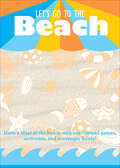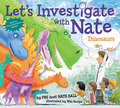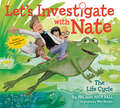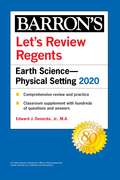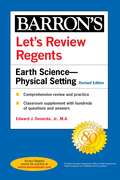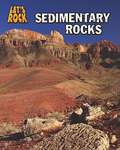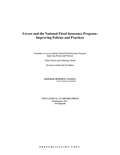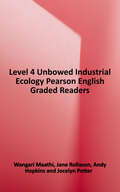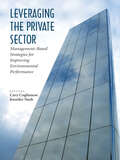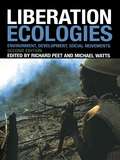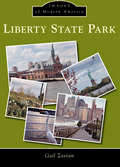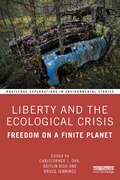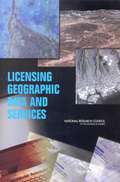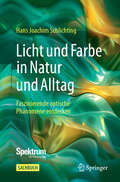- Table View
- List View
Let's Go Rock Collecting (Let's-read-and-find-out Science #1)
by Roma GansDescribes the formation and characteristics of igneous, metamorphic, and sedimentary rocks and how to recognize and collect them
Let's Go to the Beach
by Chronicle BooksA kid&’s guide to fun in the sun, packed with seaside trivia and beach-friendly games and activities. Let&’s Go to the Beach includes everything kids need to have a blast at the beach! Discover: fun facts about oceans, marine life, seashells, and more tips on enjoying the beach safely sea-themed activities, games, art projects, and scavenger hunts things to do on your own or with others
Let's Go to the Beach: A History of Sun and Fun by the Sea
by Elizabeth Van SteenwykAn intriguing exploration of a favorite pastime -- a trip to the beach. "One night in 1883, David Bradley's candy stand was swamped by a storm. Not one to take a direct hit from adversity, the next day he decided to call his candy salt water taffy. Although the taffy's been dry ever since, the name has stuck for the past hundred years." Did you know that women once wore corsets under their bathing suits (all drowning risks aside)? Or that beach-goers donned everything from wings to webbed gloves in hopes of learning how to swim? Or that hotel entrepreneurs lured wealthy customers to their seaside resorts with breakfast serenades from a forty-piece orchestra? From the bathhouses of the ancient Greeks to Muscle Beach and Coney Island, Let's Go to the Beach takes a historical, sociological, and geographical look at beaches and their attendant customs. With humor and intelligence, Elizabeth Van Steenwyk offers up an impressive overview of one of the world's greatest pastimes.
Let's Investigate with Nate #1: The Water Cycle (Let's Investigate with Nate #1)
by Nate BallBill Nye the Science Guy meets The Magic School Bus!This is the first book in a new STEM-based picture book series from the Emmy Award-winning host of PBS’s Design Squad and Design Squad Nation, Nate Ball. With a lively cast of characters and vibrant illustrations by Wes Hargis, it's an adventure in learning! This nonfiction picture book is an excellent choice to share during homeschooling, in particular for children ages 4 to 6. It’s a fun way to learn to read and as a supplement for activity books for children.Ever wonder where water comes from and where it goes? Or why sometimes it rains and sometimes it snows? Then join Nate Ball and his crack team of curious scientists as they shrink down smaller than a raindrop to see firsthand what the water cycle is all about.
Let's Investigate with Nate #2: The Solar System (Let's Investigate with Nate #2)
by Nate BallBill Nye the Science Guy meets The Magic School Bus!This is the second book in a new STEM-based picture book series from the Emmy Award-winning host of PBS’s Design Squad and Design Squad Nation, Nate Ball. With a lively cast of characters and vibrant illustrations by Wes Hargis, it's an adventure in learning!Ever look up at the sky and wonder how many planets there are? Or want to know how many Earths could fit within the Sun? Take a ride 3.6 billion miles away to answer these questions and more while exploring the solar system with Nate and his team of adventurous scientists! Walk on the moon, fly with a satellite, gaze at comets, and discover why Pluto isn’t a planet anymore.
Let's Investigate with Nate #3: Dinosaurs (Let's Investigate with Nate #3)
by Nate BallBill Nye the Science Guy meets the Magic School Bus in this new STEM-based picture book series from the Emmy Award-winning host of PBS’s Design Squad and Design Squad Nation, Nate Ball. This nonfiction picture book is an excellent choice to share during homeschooling, in particular for children ages 4 to 6. It’s a fun way to learn to read and as a supplement for activity books for children.Ever head to the museum and wish you could go back in time to see how big dinosaurs really were? Or think about what dinosaurs ate and where they lived? Follow Nate and his diverse team of intrepid scientists as they travel back across the millennia to dig up prehistoric fossils, travel across ancient landscapes, and discover what caused the dinosaur’s mass extinction. Featuring vibrant illustrations by Wes Hargis and a lively and a lovable cast of characters, the Let’s Investigate with Nate books align to grade-appropriate state-level learning standards and curriculum.With sidebars and charts and graphs and interactive elements—including a Do It Yourself experiment at the back of the book—Dinosaurs takes young readers on an adventure in learning and makes learning an adventure!
Let's Investigate with Nate #4: The Life Cycle (Let's Investigate with Nate #4)
by Nate BallBill Nye the Science Guy meets the Magic School Bus in this new STEM-based picture book series from the Emmy Award-winning host of PBS’s Design Squad and Design Squad Nation, Nate Ball. This nonfiction picture book is an excellent choice to share during homeschooling, in particular for children ages 4 to 6. It’s a fun way to learn to read and as a supplement for activity books for children.Ever stop to smell the roses and wonder how they got there? Ever think about how tadpoles become frogs and how caterpillars become butterflies? Or want to know how they’re all connected?Follow Nate and his team of plucky scientists as they morph into tiny seeds, slippery tadpoles, and fuzzy caterpillars to learn about the life cycle. While on this adventure, learn all about how plants make food from the sun, why some animals transform as they mature, and what truly defines a living thing in this brand-new adventure from everyone’s favorite fun-loving scientist and Emmy Award–winning PBS star, Nate Ball.Featuring vibrant illustrations by Wes Hargis and a lively and a lovable cast of characters, the Let’s Investigate with Nate books align to grade-appropriate state-level learning standards and curriculum. With sidebars and charts and graphs and interactive elements—including a Do It Yourself experiment at the back of the book—The Life Cycle takes young readers on an adventure in learning and makes learning an adventure!
Let's Play Soldier, George Washington! (Before I Made History)
by Peter Roop Connie RoopWhat you might not know is that: General Washington led our American army to victory in the Revolutionary War. President Washington was our first President. George Washington had no children of his own. George Washington fought a war so Americans could be free. We celebrate George Washington's birthday in February on Presidents' Day. But did you know George Washington really had two birthdays? George Washington's face is on every dollar bill.
Let's Review Regents: Earth Science--Physical Setting 2020 (Barron's Regents)
by Edward J. Denecke Jr.Barron's Let's Review Regents: Earth Science 2020 gives students the step-by-step review and practice they need to prepare for the Regents exam. This updated edition is an ideal companion to high school textbooks and covers all Physical Setting/Earth Science topics prescribed by the New York State Board of Regents. This useful supplement to high school Earth Science textbooks features:Comprehensive topic review covering fundamentals such as astronomy, geology, and meteorology. The 2011 Edition Reference Tables for Physical Setting/Earth ScienceMore than 1,100 practice questions with answers covering all exam topics drawn from recent Regents examsOne recent full-length Regents exam with answersLooking for additional practice and review? Check out Barron’s Regents Earth Science Power Pack 2020 two-volume set, which includes Regents Exams and Answers: Earth Science 2020 in addition to Let’s Review Regents: Earth Science 2020.
Let's Review Regents: Earth Science--Physical Setting Revised Edition (Barron's Regents NY)
by Edward J. Denecke Jr.Barron's Let's Review Regents: Earth Science 2020 gives students the step-by-step review and practice they need to prepare for the Regents exam. This updated edition is an ideal companion to high school textbooks and covers all Physical Setting/Earth Science topics prescribed by the New York State Board of Regents. All Regents test dates for 2020 have been canceled. Currently the State Education Department of New York has released tentative test dates for the 2021 Regents. The dates are set for January 26-29, 2021, June 15-25, 2021, and August 12-13th. This useful supplement to high school Earth Science textbooks features:Comprehensive topic review covering fundamentals such as astronomy, geology, and meteorologyThe 2011 Edition Reference Tables for Physical Setting/Earth ScienceMore than 1,100 practice questions with answers covering all exam topics drawn from recent Regents examsOne recent full-length Regents exam with answersLooking for additional practice and review? Check out Barron&’s Regents Earth Science Power Pack 2020 two-volume set, which includes Regents Exams and Answers: Earth Science 2020 in addition to Let&’s Review Regents: Earth Science 2020.
Let's Rock: Sedimentary Rocks
by Chris OxladeSedimentary Rocks looks at how sedimentary rocks form, change, move, evolve, erode, and are recycled around the world.
Letters From Katrina: Stories Of Hope And Inspiration
by Mark Hoog Kim LemaireThis project began in the spring of 2005 when students in one elementary classroom in Colorado were asked to participate in a unique book drive for the children along the gulf coast. Each Colorado student was given a new Growing Field children's picture book and, inside of it, invited to write a letter to a student along the gulf coast affected by Hurricane Katrina. The result, which includes schools, classrooms and students from California to Virginia, has been magical. In searching their heart and mind for meaningful words to write. . . the children found their own voice of value and a way to make their own special contribution. Through their words of hope, inspiration and friendship they have reached out to inspire their friends throughout Mississippi to believe that life is still without limit. The letters written by our next greatest generation are profiled in this new book and will soon be available for you to purchase. This elegant coffee table book illustrates the difference each of us makes when reaching out to others in need. The letters written by elementary students serve as a powerful reminder that the world can be changed when we ask not about gender, race, religion or socio-economic status but instead share with others six magical words that will truly change the world. . . I hope we can be friends. 100% of the proceeds from the sale of this book will be placed in an endowment that will create a lifetime of scholarships and opportunity for children throughout Mississippi and the Gulf Coast.
Levees and Dams: Advances in Geophysical Monitoring and Characterization
by Juan Lorenzo William DollThis book aims to inform policy-makers, engineers and earth scientists about the current and emerging role of geophysics in addressing environmental processes, assessments, and policy directions related to new and existing dams and levees. Until now geophysics has concentrated on characterization and remediation of dams and levees, but now the field is changing our understanding on the influence of natural processes (e.g., floods, dissolution) and human activities in the design, and management of these structures.This monograph includes advances in the following fields of Dams and Levees studies: · New insights from small and mid-sized laboratory experiments· Integrated methods electromagnetic, seismic, potential methods· Inverse modeling approaches· Statistical considerations· Monitoring of processes attending aging structures · Hazard monitoring· Risk Analysis
Levees and the National Flood Insurance Program
by Committee on Levees the National Flood Insurance Program Improving Policies PracticesThe Federal Emergency Management Agency's (FEMA) Federal Insurance and Mitigation Administration (FIMA) manages the National Flood Insurance Program (NFIP), which is a cornerstone in the U. S. strategy to assist communities to prepare for, mitigate against, and recover from flood disasters. The NFIP was established by Congress with passage of the National Flood Insurance Act in 1968, to help reduce future flood damages through NFIP community floodplain regulation that would control development in flood hazard areas, provide insurance for a premium to property owners, and reduce federal expenditures for disaster assistance. The flood insurance is available only to owners of insurable property located in communities that participate in the NFIP. Currently, the program has 5,555,915 million policies in 21,881 communities3 across the United States. The NFIP defines the one percent annual chance flood (100-year or base flood) floodplain as a Special Flood Hazard Area (SFHA). The SFHA is delineated on FEMA's Flood Insurance Rate Maps (FIRM's) using topographic, meteorologic, hydrologic, and hydraulic information. Property owners with a federally back mortgage within the SFHAs are required to purchase and retain flood insurance, called the mandatory flood insurance purchase requirement (MPR). Levees and floodwalls, hereafter referred to as levees, have been part of flood management in the United States since the late 1700's because they are relatively easy to build and a reasonable infrastructure investment. A levee is a man-made structure, usually an earthen embankment, designed and constructed in accordance with sound engineering practices to contain, control, or divert the flow of water so as to provide protection from temporary flooding. A levee system is a flood protection system which consists of a levee, or levees, and associated structures, such as closure and drainage devices, which are constructed and operated in accordance with sound engineering practices. Recognizing the need for improving the NFIP's treatment of levees, FEMA officials approached the National Research Council's (NRC) Water Science and Technology Board (WSTB) and requested this study. The NRC responded by forming the ad hoc Committee on Levee and the National Flood Insurance Program: Improving Policies and Practices, charged to examine current FEMA treatment of levees within the NFIP and provide advice on how those levee-elated policies and activities could be improved. The study addressed four broad areas, risk analysis, flood insurance, risk reduction, and risk communication, regarding how levees are considered in the NFIP. Specific issues within these areas include current risk analysis and mapping procedures behind accredited and non-accredited levees, flood insurance pricing and the mandatory flood insurance purchase requirement, mitigation options to reduce risk for communities with levees, flood risk communication efforts, and the concept of shared responsibility. The principal conclusions and recommendations are highlighted in this report.
Level 4: Industrial Ecology (Pearson English Graded Readers Ser.)
by Wangari MaathiPearson English Readers bring language learning to life through the joy of reading. Well-written stories entertain us, make us think, and keep our interest page after page. Pearson English Readers offer teenage and adult learners a huge range of titles, all featuring carefully graded language to make them accessible to learners of all abilities. Through the imagination of some of the world’s greatest authors, the English language comes to life in the pages of our Readers. Students have the pleasure and satisfaction of reading these stories in English, and at the same time develop a broader vocabulary, greater comprehension and reading fluency, improved grammar, and greater confidence and ability to express themselves.
Leveraging the Private Sector: Management-Based Strategies for Improving Environmental Performance
by Cary Coglianese Jennifer NashLeveraging the Private Sector offers the first sustained analysis of public and private sector initiatives designed to encourage firms and industries to use their own management expertise to improve their environmental performance. Cary Coglianese and Jennifer Nash bring together original empirical studies by the nation?s leading experts on recent public and private sector experiments. Do management-based strategies lead to improved environmental outcomes? What kinds of strategies hold the most promise? Leveraging the Private Sector addresses these questions through studies of state pollution prevention planning laws, private sector purchasing requirements, and federal risk management regulations, among others. The contributors show that efforts to leverage private sector experience and knowledge can have a distinctive contribution in the future of environmental protection. Ultimately, a firm's broader management practices shape its environmental performance. Public and private sector strategies that seek to influence these practices directly can help bring about further environmental improvements. This book breaks new ground by investigating a new and promising approach for advancing the economy and the environment.
Lewis Mumford and Patrick Geddes: The Correspondence
by Frank G. NovakFirst published in 1995. Routledge is an imprint of Taylor & Francis, an informa company.
Liberalism and the Challenge of Climate Change
by Christopher ShawIn this book Christopher Shaw analyses how liberalism has shaped our understanding of climate change and how liberalism is legitimated in the face of a crisis for which liberalism has no answers.The language and symbolism we use to make sense of climate change arose in the post-World War II liberal institutions of the West. This language and symbolism, in neutralising the philosophical and ideological challenge climate change poses to the legitimacy of free market liberalism, has also closed off the possibility of imagining a different kind of future for humanity. The book is structured around a repurposing of the ‘guardrail’ concept, commonly used in climate science narratives to communicate the boundary between safe and dangerous climate change. Five discursive ‘guardrails’ are identified, which define a boundary between safe and dangerous ideas about how to respond to climate change. The theoretical treatment of these issues is complemented with data from interviews with opinion-formers, decision-makers and campaigners, exploring what models of human nature and political possibilities guide their approach to the politics of climate change governance.This book will be of great interest to students and scholars of climate change, liberal politics, environmental communication and environmental politics and philosophy, in general.
Liberation Ecologies: Environment, Development and Social Movements
by Richard Peet Michael WattsLiberation Ecologies brings together some of the most exciting theorists in the field to explore the impact of political ecology in today's developing world. The book casts new light on the crucial interrelations of development, social movements and the environment in the South - the 'bigger' half of our planet - and raises questions and hopes about change on the global scale. The in-depth case material is drawn from across the Developing World, from Latin America, Africa and Asia. The issues raised in contemporary political, economic and social theory are illustrated through these case studies. Ultimately, Liberation Ecologies questions what we understand by 'development', be it mainstream or alternative, and seeks to renew our sense of nature's range of possibilities.
Liberty State Park (Images of Modern America)
by Gail ZavianSituated on the Hudson River, the Central Railroad of New Jersey terminal operated its railroad/maritime complex for over 100 years in this area. After its shutdown in 1967, community advocates, already lobbying for nine years, continued their successful campaign for the site to become a public park. With over 1,000 acres, Liberty State Park opened on Flag Day--June 14, 1976. Today, this recreational landscape features the Nature Interpretive Center, Liberty Science Center, and a section of the Hudson River Waterfront Walkway. Liberty State Park, in Jersey City, is the only place in New Jersey where one can board a ferry to visit Ellis Island and the Statue of Liberty. Liberty State Park showcases the rich cultural and environmental history of this landscape's transformation from an abandoned waterfront transportation hub into one of America's most exceptional state parks.
Liberty State Park (Images of Modern America)
by Gail ZavianSituated on the Hudson River, the Central Railroad of New Jersey terminal operated its railroad/maritime complex for over 100 years in this area. After its shutdown in 1967, community advocates, already lobbying for nine years, continued their successful campaign for the site to become a public park. With over 1,000 acres, Liberty State Park opened on Flag Day--June 14, 1976. Today, this recreational landscape features the Nature Interpretive Center, Liberty Science Center, and a section of the Hudson River Waterfront Walkway. Liberty State Park, in Jersey City, is the only place in New Jersey where one can board a ferry to visit Ellis Island and the Statue of Liberty. Liberty State Park showcases the rich cultural and environmental history of this landscape's transformation from an abandoned waterfront transportation hub into one of America's most exceptional state parks.
Liberty and the Ecological Crisis: Freedom on a Finite Planet (Routledge Explorations in Environmental Studies #1)
by Bruce Jennings Christopher J. Orr Kaitlin KishThis book examines the concept of liberty in relation to civilization’s ability to live within ecological limits. Freedom, in all its renditions – choice, thought, action – has become inextricably linked to our understanding of what it means to be modern citizens. And yet, it is our relatively unbounded freedom that has resulted in so much ecological devastation. Liberty has piggy-backed on transformations in human–nature relationships that characterize the Anthropocene: increasing extraction of resources, industrialization, technological development, ecological destruction, and mass production linked to global consumerism. This volume provides a deeply critical examination of the concept of liberty as it relates to environmental politics and ethics in the long view. Contributions explore this entanglement of freedom and the ecological crisis, as well as investigate alternative modernities and more ecologically benign ways of living on Earth. The overarching framework for this collection is that liberty and agency need to be rethought before these strongly held ideals of our age are forced out. On a finite planet, our choices will become limited if we hope to survive the climatic transitions set in motion by uncontrolled consumption of resources and energy over the past 150 years. This volume suggests concrete political and philosophical approaches and governance strategies for learning how to flourish in new ways within the ecological constraints of the planet. Mapping out new ways forward for long-term ecological well-being, this book is essential reading for students and scholars of ecology, environmental ethics, politics, and sociology, and for the wider audience interested in the human–Earth relationship and global sustainability.
Liberty over London Bridge: A History of the People of Southwark
by Margaret WillesThe first complete history of Southwark, London&’s stubbornly independent community over the Thames Southwark&’s fortunes have always been tied to those of the City of London across the river. But from its founding in Roman times through to flourishing in the medieval era, the Borough has always fiercely asserted its independence. A place of licence, largely free of the City&’s jurisdiction, Southwark became a constant thorn in London&’s side: an administrative anachronism, a commercial rival, and an asylum for undesirable industries and residents. In this remarkable history of London&’s liberty beyond the bridge, Margaret Willes narrates the life and times of the people of Southwark, capturing the Borough&’s anarchic spirit of revelry. Populated by a potent mix of talented immigrants, religious dissenters, theatrical folk, brewers, and sex workers, Southwark often escaped urban jurisdiction—giving it an atmosphere of danger, misrule, and artistic freedom. Tracing Southwark&’s history from its Roman foundation to its present popularity as a place to visit, through Chaucer, to Shakespeare, and on to Dickens, Willes offers an indispensable exploration of the City&’s unacknowledged mirror image.
Licensing Geographic Data And Services
by Committee on Licensing Geographic Data ServicesGeographic data are used in all sectors of society to support a huge range of applications ranging from emergency response to land-use planning to location-based services. In the past, government agencies typically acquired ownership of such data from private-sector and other data producers and distributed these data without restriction. Licensing--whereby the producer may restrict redistribution--has emerged as an alternative business model that agencies must now consider among a suite of procurement options. The report highlights licensing perspectives and experiences of major stakeholder groups and examines the pros and cons of licensing. It concludes that licensing may be a viable option in some instances and advises agencies on how to best serve societal interests.
Licht und Farbe in Natur und Alltag: Faszinierende optische Phänomene entdecken
by Hans Joachim SchlichtingWir sind umgeben von faszinierenden optischen Phänomenen, die im Alltag meist unbemerkt bleiben. Doch was verbirgt sich hinter den strahlenförmigen Heiligenscheinen, die um den Schatten unseres Kopfes erscheinen, wenn wir in ein trübes Gewässer blicken? Haben Sie jemals die geheimnisvollen Lichtkreuze in Lichtkreisen wahrgenommen, die insbesondere am Morgen oder Abend an Häuserfronten zu sehen sind? Selbst verzerrte Mehrfachspiegelungen auf glänzenden Autokarosserien entgehen den meisten von uns. In diesem Sachbuch nehmen wir Sie mit auf eine Reise durch die Welt der verborgenen Lichterscheinungen. Entdecken Sie Phänomene wie die Quételetschen Ringe, die leuchtenden Glorien im Nebel oder die faszinierenden Strukturfarben von Spinnennetzen, die sich nur aus der passenden Perspektive offenbaren. Selbst bekannte Erscheinungen wie der Regenbogen, der eigene Schatten oder der Heiligenschein im feuchten Gras enthüllen bei genauer Betrachtung völlig neue Details und eröffnen ungeahnte Einsichten. Diese alltäglichen Phänomene werden ohne Formeln physikalisch beschrieben. Dabei erfährt vor allem die ästhetische und erlebnisorientierte Dimension durch reiche Bebilderung und Diktion eine besondere Wertschätzung.

